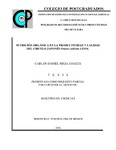Nutrición orgánica en la productividd y calidad del ciruelo japonés Prunus salicina Lindl.
Abstract
En la fruticultura moderna se busca lograr altos rendimientos por unidad de superficie, incorporando grandes volúmenes de fertilizantes minerales y pesticidas en los huertos frutales, sin considerar el impacto ambiental y los residuos tóxicos en los frutos y en la salud humana. Por este motivo, en la presente investigación se evaluó la respuesta del ciruelo japonés (Prunnus salicina Lindl) cv. Metlhey a cuatro tratamientos de fertilización, química T1 (Bayfolan+Urea+Sulfato de potasio +Nitrofoska), química orgánica T2 (Bayfolan+composta), y orgánica T3 (Phytotron+composta) y T4 (HumiExtra+composta), durante el ciclo de producción 2013-2015. Se evaluó el estado físico químico del suelo, el vigor del árbol en función de los diámetros del tronco, el rendimiento y la productividad, así como también el estado nutricional de hojas y atributos de calidad de frutos: sólidos solubles totales, acidez titulable, pH, tamaño y peso de fruta fueron determinados así como el estado nutricional de los frutos. La temperatura y la humedad de suelo también fueron registradas. Los análisis de resultados mostraron que tanto las condiciones físicas como químicas del suelo bajo tratamiento orgánico, fueron mejores, sobre todo, en contenido de materia orgánica, N, P y micronutrientes. Con respecto al rendimiento y vigor del árbol, los tratamientos no mostraron diferencias; sin embargo, el tratamiento más productivo en 2015 fue el T3. Con relación al contenido nutrimental en hoja, el T1 y T2 presentaron mayor concentración de Mg, K, Cu y Mn para 2014. Para 2015, el T3 mostró diferencias significativas en concentración foliar de Ca y Mg. En cuanto a la calidad de fruta, los sólidos solubles totales y acidez titulable para los tratamientos T1 y T2, mostraron diferencia significativa a favor, respecto a T3 y T4 en 2014. De igual forma para las variables de calidad de fruta se encontró que el peso de fruta no presentó diferencias entre los tratamientos. De acuerdo a los diámetros en 2014, los frutos más grandes se obtuvieron en T1, pero para 2015 la fruta más grande correspondió al T4. Con relación al contenido nutrimental de fruta, el T4 fue superior en la concentración de N para 2014, y T2 en ambos ciclos de producción presentó diferencias significativas con respecto a Ca, Fe y Mn. Los tratamientos para el ciclo 2015 no presentaron diferencias significativas en macronutrientes a excepción de Ca. El contenido de humedad del suelo siempre fue cercano a capacidad de campo en tratamientos orgánicos, con respecto al químico (suelo desnudo). De acuerdo con los resultados de esta investigación, se sugiere que la producción de ciruelo con los tratamientos orgánicos puede igualarse en el tiempo con aquella obtenida con fertilizantes químicos, además de ser una opción sustentable debido a que se logra optimizar el agua y mejorar la fertilidad del suelo. _______________ ORGANIC NUTRITION IN THE PRODUCTIVITY AND QUALITY OF JAPANESE PLUM Prunus salicina LINDL. ABSTRACT: In modern fruit growing, the aim is to achieve high yields per unit area, incorporating large volumes of mineral fertilizers and pesticides in the fruit orchards, without considering the environmental impact and the toxic residues on the fruits and human health. For this reason, the present investigation evaluated the response of Japanese plum (Prunnus salicina Lindl) cv. Metlhey to four fertilization treatments, chemical T1 (Bayfolan + Urea + Potassium sulphate + Nitrofoska), organic chemistry T2 (Bayfolan + composite), and organic T3 (Phytotron + composite) and T4 (HumiExtra + composite), during the Production 2013-2015. The physical state of the soil, the vigor of the tree in terms of trunk diameters, yield and productivity, as well as leaf nutritional status and fruit quality attributes were evaluated: total soluble solids, titratable acidity, pH , Fruit size and weight were determined as well as the nutritional status of the fruits. Soil temperature and humidity were also recorded. The results showed that both the physical and chemical conditions of the soil under organic treatment were better, especially in organic matter, N, P and micronutrients content. Regarding the yield and vigor of the tree, the treatments did not show differences; However, the most productive treatment in 2015 was T3. In relation to leaf nutrient content, T1 and T2 presented higher concentration of Mg, K, Cu and Mn for 2014. By 2015, T3 showed significant differences in Ca and Mg foliar concentration. As for fruit quality, total soluble solids and titratable acidity for treatments T1 and T2, showed a significant difference in favor, compared to T3 and T4 in 2014. Likewise for fruit quality variables, it was found that Fruit weight did not show differences between treatments. According to the diameters in 2014, the largest fruits were obtained in T1, but by 2015 the largest fruit corresponded to T4. Regarding the nutritional content of fruit, T4 was higher in the concentration of N for 2014, and T2 in both cycles of production presented significant differences with respect to Ca, Fe and Mn. The treatments for the 2015 cycle did not present significant differences in macronutrients with the exception of Ca. The soil moisture content was always close to field capacity in organic treatments, with respect to the chemical (bare soil). According to the results of this research, it is suggested that the production of plum with organic treatments can be equal in time with that obtained with chemical fertilizers, besides being a sustainable option because it is possible to optimize water and improve soil fertility.
Collections
- Tesis MC, MT, MP y DC [138]


